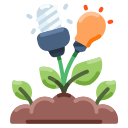Technological Advances in Urban Garden Design
Urban gardening is undergoing a remarkable transformation thanks to cutting-edge technology. Innovative solutions are reshaping how cities incorporate green spaces, enabling more efficient use of limited space, improved sustainability, and greater community engagement. The integration of smart systems, advanced materials, and data-driven tools is not only making urban gardens more productive, but also more accessible and environmentally responsive. This page explores the forefront of technological advances driving the future of urban garden design.

Smart Irrigation and Water Management
Soil Moisture Sensors
Soil moisture sensors have become indispensable tools in urban gardens. These devices constantly monitor the moisture content of the soil, providing real-time data that allows for precision watering. By taking the guesswork out of irrigation, soil moisture sensors help prevent both overwatering and underwatering, which can otherwise lead to unhealthy plants and wasted resources. The integration of these sensors with mobile applications enables gardeners to receive alerts and make informed decisions from anywhere, turning traditional urban gardening into a data-driven practice. As these sensors become increasingly affordable and easy to install, they are rapidly becoming standard in urban garden design.
Automated Drip Systems
Automated drip systems represent a leap forward in water efficiency for urban gardens. These systems use a network of tubes and emitters to deliver water directly to the base of plants at scheduled intervals. By targeting root zones instead of broad surface areas, drip systems minimize evaporation and runoff, ensuring that each plant receives just the right amount of water. When connected to smart controllers and integrated with weather forecasts, these systems can adjust watering schedules automatically in response to climatic conditions. The results are healthier plants, lower utility bills, and a significant reduction in water waste—a critical concern in dense urban settings.
Predictive Weather Analytics
Leveraging predictive weather analytics allows urban gardeners to anticipate and respond to environmental changes more effectively. By analyzing a blend of historical and real-time weather data, sophisticated software can forecast patterns like rainfall, humidity, and temperature fluctuations. This information is crucial for optimizing irrigation schedules, preventing disease outbreaks, and reducing stress on plants due to sudden weather changes. Urban garden managers can use predictive weather analytics to plan ahead, ensuring resilience and adaptability. These tools empower gardeners to optimize growing conditions and make better use of their available resources, all while minimizing environmental impact.
Previous
Next
Data-Driven Garden Management
Garden Monitoring Platforms
Modern garden monitoring platforms serve as the nerve center for technologically advanced urban gardens. These platforms aggregate data from a range of sensors—measuring temperature, humidity, light intensity, and plant growth—into a central dashboard. Gardeners can visualize trends, set automated alerts, and intervene proactively to address issues before they escalate. Integration with smartphones and cloud-based software means this information is available in real-time, allowing for remote oversight and collaboration among community members. By centralizing all aspects of garden monitoring, these platforms empower both amateur and professional gardeners to achieve higher productivity and sustainability in their urban gardens.
Integrated Pest and Disease Detection
Integrated pest and disease detection harnesses machine learning and sensor technology to safeguard urban gardens. High-resolution cameras and environmental sensors continuously scan plants for signs of infection or infestation, comparing images and data against extensive databases to identify potential threats early. These systems can recommend targeted interventions, reducing the need for broad-spectrum pesticides and minimizing damage. By enabling early detection and precise management, integrated pest and disease detection technology reduces crop loss, saves resources, and maintains the ecological balance in urban settings.
Automated Resource Allocation
Automated resource allocation systems intelligently distribute water, nutrients, and even energy within complex urban gardens. These systems use comprehensive data models to understand individual plant needs and environmental variables, adjusting inputs to maximize growth and efficiency. Automation reduces the manual workload associated with maintaining a productive urban garden, enabling gardeners to focus on creativity and expansion instead of daily maintenance. By aligning resource delivery with actual demand, these systems not only promote plant health but also contribute to overall sustainability strategies across the urban landscape.
